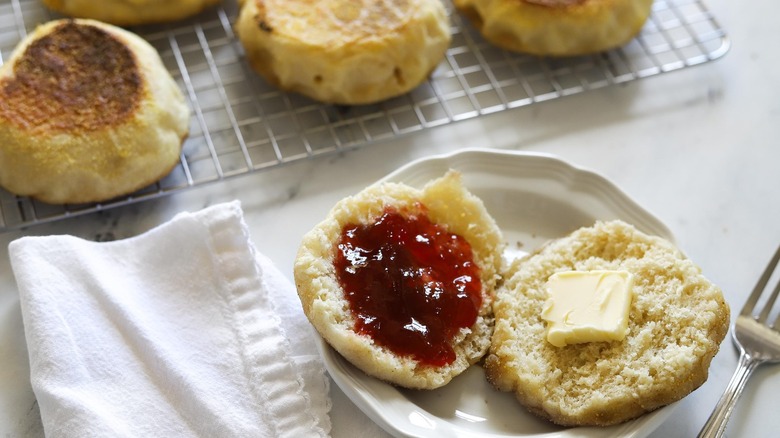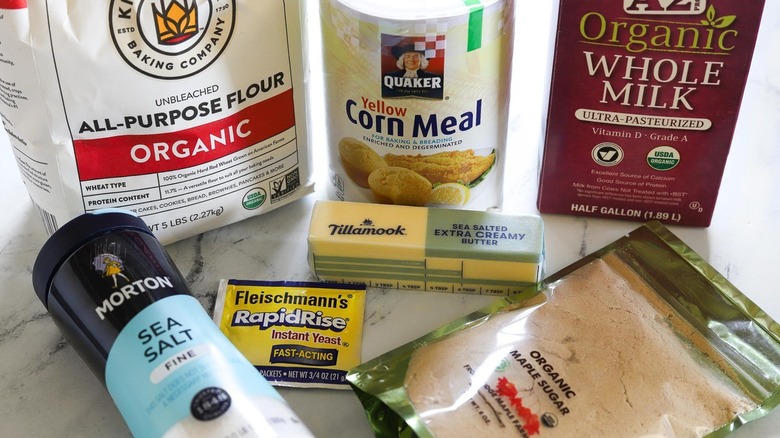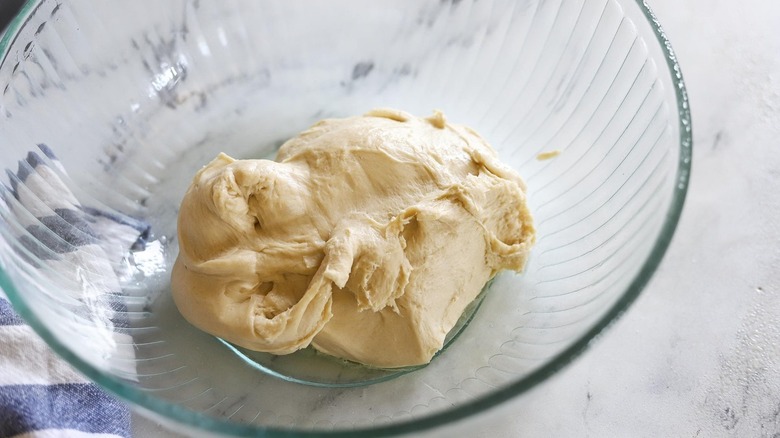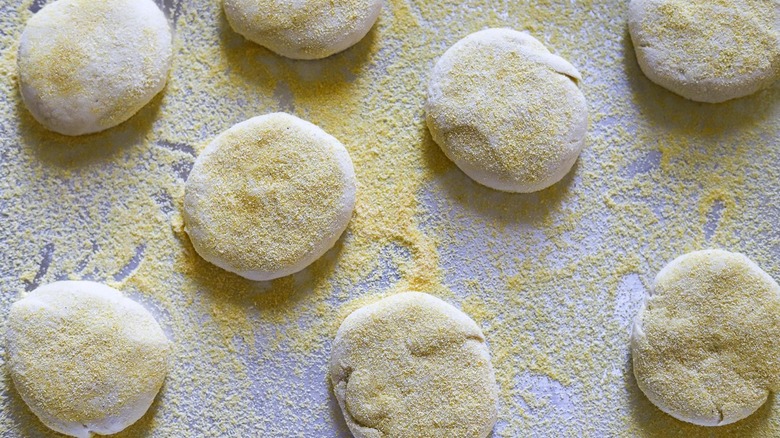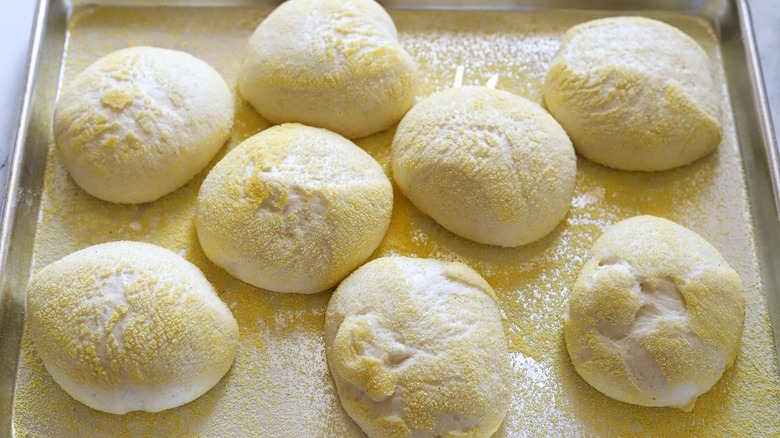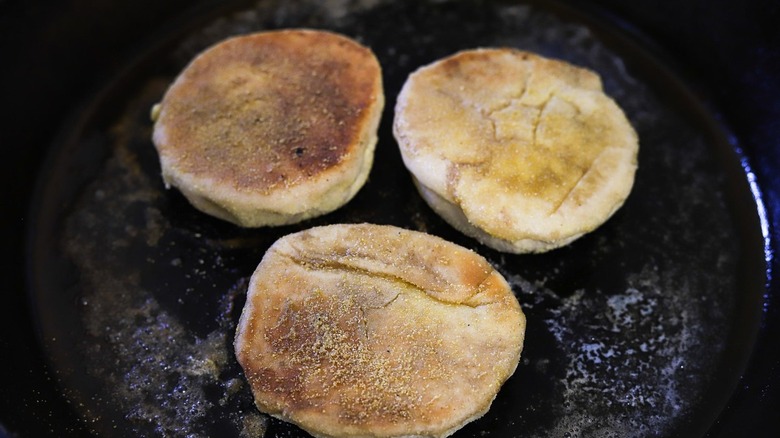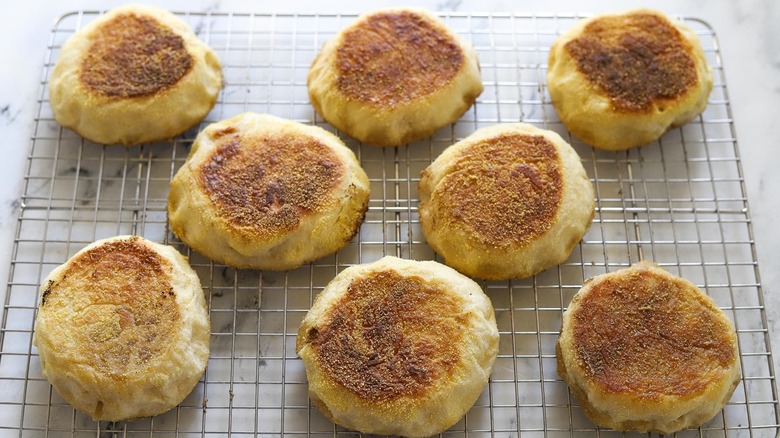Homemade English Muffin Recipe
We may receive a commission on purchases made from links.
English muffins are a bit of an anomaly. For one thing, they bear very little resemblance to muffins as we know them. For another, well, their provenance is somewhat mysterious, although it seems that the ones we're familiar with were introduced by a British immigrant (one Mr. Thomas, whose name lives on in the famous brand). They were first marketed in New York, however, under the name "toaster crumpets." Crumpets and other similar baked goods were known in England as well, but had certainly never been sold as "English muffins."
One of the many things that sets English muffins apart from muffin muffins is that while they can be baked, they are often cooked in a pan instead, as is the case here. Recipe developer Kit Hondrum says this gives them a "more authentic" look that she craves, contrasting them to "those [English muffins] made in bakeries [that] have perfect sides." This symmetry, she explains, comes from the muffins being cooked in molds, but that's not something you'll be needing here. We're going for a more rustic vibe.
These skillet-cooked muffins, Hondrum says, "are great fresh and do [not] need to be toasted if eaten the same day," but she does recommend toasting them if eating them later on, explaining that this gives them "extra flavor and crispy edges."
Gather the ingredients for these English muffins
Most of the ingredients you'll need to make these muffins are basic pantry staples. They are made with all-purpose flour, salt, butter, milk, water, yeast, and sugar. Hondrum chooses to make hers with maple sugar, but brown sugar makes a great substitute; white sugar will also work just fine.
One other item Hondrum uses, although it doesn't get mixed into the dough, is cornmeal to keep the unbaked muffins from sticking to the pan. This is also what gives the muffins that sandy crunch on the outside. Coarse semolina is also a good option for this step.
Make the dough for the English muffins
Start by melting 1 ½ tablespoons butter. Combine the flour, yeast, salt, and sugar, then slowly stir in the butter. Keep stirring the mixture for a minute, then add the milk and water. Knead the dough (either in a mixer with a dough hook or by hand) for 6 or 7 minutes, or until the dough looks smooth and supple. If you're using a stand mixer, the dough will also start to pull away from the sides. Put the dough in an oiled bowl, cover it, then stick it in the refrigerator for 8 hours or overnight.
Shape the dough for the English muffins
Divide the chilled dough into 8 equal pieces; it may help to shape it into a log, then cut the log in half, then in half again, then in half one more time (math!). If you have a kitchen scale, you can also weigh each piece to make sure they're even. Roll each piece into a ball.
Once you have your dough balls, sprinkle a sheet pan with half of the cornmeal or semolina, then put the rest in a bowl. Roll the dough balls in the cornmeal (or semolina) in the bowl, then arrange the dough on the baking sheet, flattening them slightly into discs and leaving about 1 ½ inch between each one.
Let the dough rise
Cover the pan with another baking sheet or a damp towel and let the dough rise for 1 to 2 hours, or until the muffins-to-be are about 1 ½ times as large as they were when you shaped them. "I let mine rise in the oven using the proof setting," Hondrum says, adding that at sea level, it still takes about 1 hour 15 minutes for her dough to rise. Depending on your altitude, room temperature, etc., your rising time may vary, but that's just the mysterious way of yeast breads.
Cook the English muffins
Heat a skillet (preferably cast-iron) over low heat and melt 2 tablespoons of butter. Put about 3 or 4 dough discs in the pan, then cook them for 8 minutes. Flip them over and cook for another 8 to 9 minutes. One trick is to rotate the muffins ¼ turn every few minutes. Not only will this help them cook more evenly, but, as Hondrum says, it will give them "little indents on the sides" that add a cute rustic touch. Before you start the next batch of muffins, add another tablespoon of butter and wait until the butter has melted to add the dough.
Let the english muffins cool
Once all of the muffins are cooked, wait until they cool completely before you attempt to slice them — or, as Hondrum insists, "pry [them] open with a fork." She feels the fork method allows for better "nooks and crannies," as the famous phrase dreamed up by a 1970s focus group and popularized by Thomas' commercials would have it. There are others, however, who feel that the best option is to pull the English muffin apart with your hands. You know what? Go ahead and open your muffin any way you want; it'll still be good.
Homemade English Muffin Recipe
In a bakery, you might find English muffins that are perfectly round and even. These are not that. Instead, this recipe produces wonderfully rustic muffins.
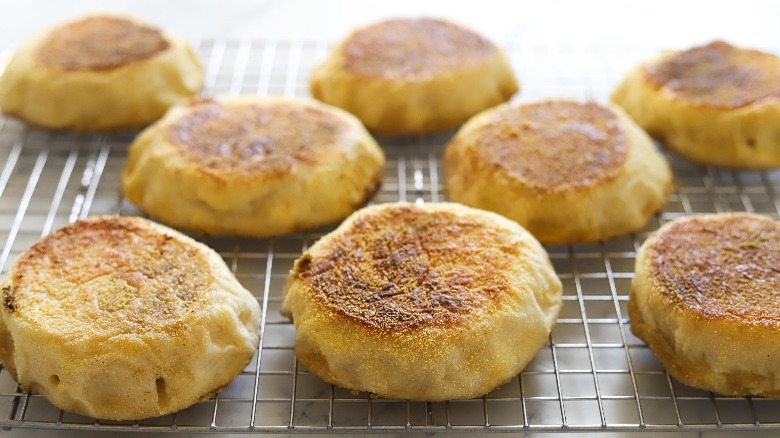
Ingredients
- 2 ½ cups all-purpose flour
- 1 teaspoon instant dry yeast
- 1 ½ teaspoons salt
- 1 tablespoon sugar (maple or brown, preferably)
- 5 ½ tablespoons butter, divided
- ½ cup milk, at room temperature
- 6 tablespoons water, at room temperature
- ½ cup cornmeal or semolina, for dusting
Directions
- Melt 1 ½ tablespoons butter.
- Mix flour, yeast, salt, and sugar in a mixing bowl. Slowly add in the melted butter.
- Mix the dough for 1 minute after the butter is incorporated, then add the milk and water.
- Knead the dough (use the dough hook if you have a stand mixer; if not, knead by hand) for 6 to 7 minutes or until it looks smooth.
- Place the dough into an oiled bowl, cover, then refrigerate it for 8 hours or overnight.
- Divide the dough into 8 equal pieces; roll each one into a ball.
- Sprinkle a sheet pan with half of the cornmeal or semolina. Put the rest in a bowl.
- Dip each dough ball in the bowl of cornmeal, making sure to cover all sides.
- Arrange the dough balls on the baking sheet, slightly flattening them into discs and leaving 1 ½ inches of space between each one.
- Cover the pan with another pan or a damp towel and let the dough rise at room temperature for 1 to 2 hours, or until it has increased to about 1 ½ times its former size.
- Heat a skillet (preferably cast-iron) over low heat, then melt 2 tablespoons of butter.
- Place 3 to 4 English muffins into the skillet. Cook for 8 minutes, rotating the muffins ¼ turn every 2 minutes or so.
- Flip the muffins and cook them for 8 to 9 more minutes, again rotating occasionally.
- When the first batch is done, add another tablespoon of butter to the pan and start the second batch. Repeat until all of the muffins have been cooked.
- Allow the muffins to cool completely before opening.
- Store the muffins at room temperature for 4 days or freeze for later use.
Nutrition
| Calories per Serving | 265 |
| Total Fat | 9.0 g |
| Saturated Fat | 5.4 g |
| Trans Fat | 0.3 g |
| Cholesterol | 22.5 mg |
| Total Carbohydrates | 40.1 g |
| Dietary Fiber | 1.6 g |
| Total Sugars | 2.6 g |
| Sodium | 202.4 mg |
| Protein | 5.5 g |
